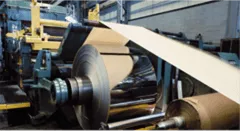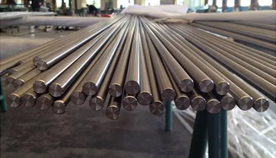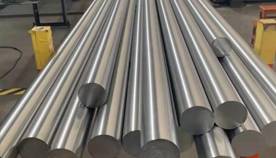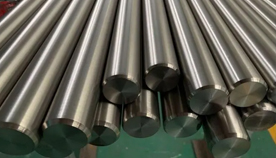

live a message
1 : GB 228 metal tensile test method 2: GB/T 3620.1 Titanium and titanium alloy grades and chemical composition 3: GB/T3620.2 Titanium and titanium alloy processed products chemical composition and composition allowable deviation 4: GB 4698 sponge titanium, titanium and titanium alloy chemical analysis methods
1: The chemical composition of titanium and titanium alloy bars should comply with GB/T 3620.1, the provisions of the need for repeated testing, the allowable deviation of the chemical composition should comply with the provisions of GB/T 3620.2.
2: The diameter or edge length of the hot-processed bar and its allowable deviation should be in line with the provisions of Table 1.
3: After hot processing by turning (grinding) polished bars and cold-rolled, cold-drawn bars should meet the allowable deviation of the diameter of the provisions of Table II.
4: After hot processing by turning (grinding) polished bars should not be more than half of its size tolerance.
5: Processing state of the bar's indefinite length of 300-6000mm, annealed state of the bar indefinite length of 300-2000mm, fixed length or times the length of the bar should be within the indefinite length. The allowable deviation of the fixed length is +20mm; the multi-length should also take into account the cut of the bar, each cut amount is 5mm.



| KUAIMA | Typical corresponding standard | Chemical composition(wt%) | ||||||||
| N | C | H | Fe | O | Al | V | Ti | Other elements | ||
| DT1 | JIS Class 1 | ≦0.03 | ≦0.08 | ≦0.013 | ≦0.20 | ≦0.15 | - | - | Bal | |
| ASTM Grade 1 | ≦0.03 | ≦0.08 | ≦0.015 | ≦0.20 | ≦0.18 | - | - | Bal | ||
| DIN3.7025 | ≦0.05 | ≦0.06 | ≦0.013 | ≦0.15 | ≦0.12 | - | - | Bal | ||
| DT2 | JIS Class 2 | ≦0.03 | ≦0.08 | ≦0.013 | ≦0.25 | ≦0.20 | - | - | Bal | |
| ASTM Grade 2 | ≦0.03 | ≦0.08 | ≦0.015 | ≦0.30 | ≦0.25 | - | - | Bal | ||
| DIN3.7035 | ≦0.05 | ≦0.06 | ≦0.013 | ≦0.20 | ≦0.18 | - | - | Bal | ||
| DT3 | JIS Class 3 | ≦0.05 | ≦0.08 | ≦0.013 | ≦0.30 | ≦0.30 | - | - | Bal | |
| ASTM Grade 3 | ≦0.05 | ≦0.08 | ≦0.015 | ≦0.30 | ≦0.35 | - | - | Bal | ||
| DIN3.7055 | ≦0.05 | ≦0.06 | ≦0.013 | ≦0.25 | ≦0.25 | - | - | Bal | ||
| DT4 | JIS Class 4 | ≦0.05 | ≦0.08 | ≦0.013 | ≦0.50 | ≦0.40 | - | - | Bal | |
| ASTM Grade 4 | ≦0.05 | ≦0.08 | ≦0.015 | ≦0.50 | ≦0.40 | - | - | Bal | ||
| DIN3.7065 | ≦0.05 | ≦0.06 | ≦0.013 | ≦0.30 | ≦0.35 | - | - | Bal | ||
| KUAIMA | Typical corresponding standard | Chemical composition(wt%) | ||||||||
| N | C | H | Fe | O | Al | V | Ti | Other elements | ||
| DAT5 | JIS Class 60 | ≦0.05 | ≦0.08 | ≦0.015 | ≦0.40 | ≦0.20 | 5.50~ 6.75 | 3.50~ 4.50 | Bal | |
| ASTM Grade 5 | ≦0.05 | ≦0.08 | ≦0.015 | ≦0.40 | ≦0.20 | 5.5~ 6.75 | 3.5~ 4.5 | Bal | ||
| DIN3.7164 | ≦0.05 | ≦0.08 | ≦0.0125 | ≦0.30 | ≦0.20 | 5.5~ 6.75 | 3.5~ 4.5 | Bal | ||
| AMS 4928 | ≦0.05 | ≦0.08 | ≦0.0125 | ≦0.30 | ≦0.20 | 5.50~ 6.75 | 3.50~ 4.50 | Bal | Y≦0.005 | |
| DAT5E | JIS Class 60E | ≦0.03 | ≦0.08 | ≦0.0125 | ≦0.25 | ≦0.13 | 5.50~ 6.50 | 3.50~ 4.50 | Bal | |
| ASTM F136 | ≦0.05 | ≦0.08 | ≦0.012 | ≦0.25 | ≦0.13 | 5.5~ 6.50 | 3.5~ 4.5 | Bal | ||
| AMS 4930 | ≦0.05 | ≦0.08 | ≦0.0125 | ≦0.25 | ≦0.13 | 5.50~ 6.50 | 3.50~ 4.50 | Bal | Y≦0.005 | |
| DAT67 | ASTM F1295 | ≦0.05 | ≦0.08 | ≦0.009 | ≦0.25 | ≦0.20 | 5.50~ 6.50 | - | Bal | Nb 6.50~7.50 |
| Ta≦0.50 | ||||||||||
| DAT52 | JIS Class 61 | ≦0.03 | ≦0.08 | ≦0.015 | ≦0.25 | ≦0.15 | 2.50~ 3.50 | 2.00~ 3.00 | Bal | |
| ASTM Grade 9 | ≦0.03 | ≦0.08 | ≦0.015 | ≦0.25 | ≦0.12 | 2.5~ 3.5 | 2.0~ 3.0 | Bal | ||
| DAT52F | JIS Class 61F | ≦0.05 | ≦0.10 | ≦0.015 | ≦0.30 | ≦0.25 | 2.70~ 3.50 | 1.60~ 3.40 | Bal | S 0.05~0.20 |
| (Material for free cutting) | REM 0.05~0.70 | |||||||||
| DAT51 | JIS Class 80 | ≦0.05 | ≦0.10 | ≦0.015 | ≦1.00 | ≦0.25 | 3.50~ 4.50 | 20.0~ 23.0 | Bal | |
| (Material for cold working) | ||||||||||
| DAT54 | Daido original standard | ≦0.05 | ≦0.20 | ≦0.015 | ≦1.00 | ≦0.25 | 5.5~ 6.5 | - | Bal | Si 0.2~0.7 |
| Mo 2.5~3.5 | ||||||||||
| Sn 3.0~4.5 | ||||||||||
| Zr 3.0~4.0 | ||||||||||
| Nb 0.4~1.0 | ||||||||||
| DAT55G | Daido original standard | ≦0.05 | ≦0.10 | ≦0.015 | ≦1.00 | ≦0.25 | 3.5~ 4.5 | 15.0~ 17.0 | Bal | Cr 5.0~7.0 |
| DAT56M | Daido original (CATi) | ≦0.05 | ≦0.10 | ≦0.015 | 0.4~1.5 | ≦0.30 | 2.5~ 3.5 | - | Bal | Cr 12.5~14.5 |
| DAT57M | Daido original (VLTi) | ≦0.05 | ≦0.10 | ≦0.015 | 0.4~1.5 | ≦0.30 | 5.5~ 6.5 | - | Bal | |
| ASTM Grade41 | ||||||||||
| DAT15G | AMS4914 | ≦0.05 | ≦0.05 | ≦0.015 | ≦0.25 | ≦0.13 | 2.5~ 3.5 | 14.0〜 16.0 | Bal | Cr 2.5〜3.5 |
| Sn 2.5〜3.5 | ||||||||||
| KUAIMA | Typical corresponding standard | Tensile strength | 0.2% Yield strength | Elongation | Reduction of area | 180° bending | Hardness | Heat treatment condition |
| BRAND | (N/mm2) | (N/mm2) | (%) | (%) | (inner radius) | (HB) | ||
| DT1 | JIS Class 1 | 270~410 | ≧165 | ≧27 | - | 2T | ≧100 | Annealing |
| ASTM Grade 1 | ≧240 | ≧138 | ≧24 | ≧30 | - | - | Annealing | |
| DIN3.7025 | 290~410 | ≧180 | ≧30 | - | - | - | Annealing | |
| DT2 | JIS Class 2 | 340~510 | ≧215 | ≧23 | - | 2T | ≧110 | Annealing |
| ASTM Grade 2 | ≧345 | ≧275 | ≧20 | ≧30 | - | - | Annealing | |
| DIN3.7035 | 390~540 | ≧250 | ≧22 | - | - | - | Annealing | |
| DT3 | JIS Class 3 | 480~620 | ≧345 | ≧18 | - | 3T | ≧150 | Annealing |
| ASTM Grade 3 | ≧450 | ≧380 | ≧18 | ≧30 | - | - | Annealing | |
| DIN3.7055 | 460~590 | ≧320 | ≧18 | - | - | - | Annealing | |
| DT4 | JIS Class 4 | 550~750 | ≧485 | ≧15 | - | 3T | ≧180 | Annealing |
| ASTM Grade 4 | ≧550 | ≧483 | ≧15 | ≧25 | - | - | Annealing | |
| DIN3.7065 | 540~740 | ≧390 | ≧16 | - | - | - | Annealing |
| KUAIMA | Typical corresponding standard | Tensile strength | 0.2% Yield strength | Elongation | Reduction of area | 180° bending | Hardness | Heat treatment condition |
| BRAND | (N/mm2) | (N/mm2) | (%) | (%) | (inner radius) | (HB) | ||
| DAT5 | JIS Class 60 | ≧895 | ≧825 | ≧10 | ≧25 | - | - | Annealing |
| ASTM Grade 5 | ≧895 | ≧828 | ≧10 | ≧25 | - | - | Annealing | |
| DIN3.7164 | ≧900 | ≧830 | ≧10 | ≧25 | - | - | Annealing | |
| AMS 4928 | ≧896 | ≧827 | ≧10 | ≧25 | - | - | Annealing | |
| DAT5E | JIS Class 60E | ≧825 | ≧755 | ≧10 | ≧25 | - | - | Annealing |
| ASTM F136 | ≧860 | ≧795 | ≧10 | ≧25 | - | - | Annealing | |
| AMS 4930 | ≧827 | ≧758 | ≧8 | ≧15 | - | - | Annealing | |
| DAT67 | ASTM F1295 | ≧900 | ≧800 | ≧10 | ≧15 | - | - | Annealing |
| DAT52 | JIS Class 61 | ≧620 | ≧485 | ≧15 | ≧30 | - | - | Annealing |
| ASTM Grade 9 | ≧620 | ≧483 | ≧15 | ≧25 | - | - | Annealing | |
| DAT52F | JIS Class 61 | ≧650 | ≧600 | ≧10 | ≧25 | - | - | Annealing |
| (Material for free cutting) | ||||||||
| DAT51 | JIS Class 80 | 640~900 | ≦850 | ≧10 | ≧55 | - | - | Solution |
| (Material for cold working) | ||||||||
| DAT54 | Daido original standard | ≧895 | ≧825 | ≧5 | ≧10 | - | - | Annealing |
| DAT55G | Daido original standard | 770~1050 | ≦1000 | ≧10 | ≧25 | - | - | Solution |
| DAT56M | Daido original (CATi) | 850~1100 | ≦1050 | ≧10 | ≧25 | - | - | Solution |
| DAT57M | Daido original (VLTi) | ≧895 | ≧825 | ≧10 | ≧25 | - | - | Annealing |
| ASTM Grade41 | ||||||||
| DAT15G | AMS 4914 | 703〜 745 | 689〜 869 | ≧12 | - | - | - | Solution |
Dimensions (mm) | Tolerance(mm) | Ovality (mm) |
6.35 to 7.94 | ±0.13 | 0.20 |
7.94 to 11.11 | ±0.15 | 0.23 |
11.11 to 15.88 | ±0.18 | 0.25 |
15.88 to 22.22 | ±0.20 | 0.30 |
22.22 to 25.40 | ±0.23 | 0.33 |
25.40 to 28.58 | ±0.25 | 0.38 |
28.58 to 31.75 | ±0.28 | 0.41 |
31.75 to 34.92 | ±0.30 | 0.46 |
34.92 to 38.10 | ±0.36 | 0.53 |
38.10 to 50.80 | ±0.40 | 0.58 |
50.80 to 63.50 | +0.79, − 0 | 0.58 |
63.50 to 88.90 | +1.19, − 0 | 0.89 |
88.90 to 114.30 | +1.59, − 0 | 1.17 |
| Titanium steel flat | 13mm Titanium rod |
| 309 stainless steel rod | stainless steel fishing flat |
| 30mm stainless steel flat | 19mm Titanium rod |
| Titanium rod | stainless steel ground flat |
| 316l stainless steel flat | 3 4 inch Titanium rod |
| 2.5 mm Titanium rod | stainless steel flat 3/8 |
We are a well known worldwide exporter of Titanium rod, Ireland, Portugal, Gambia, Thailand, Ukraine, United Kingdom, Netherlands, South Africa, Spain, Turkey, Italy, Libya, Romania, Puerto Rico, Azerbaijan, United Arab Emirates, Pakistan, Philippines, Ghana, Slovakia, Germany, Saudi Arabia, Afghanistan, China, Bolivia, Switzerland, Bangladesh, Taiwan, Oman, Egypt, Greece, Norway, Singapore, Bulgaria, Estonia, Belgium, Yemen, Hong Kong, Ecuador, Sri Lanka, Nepal, Belarus, Finland, Gabon, Iran, Canada, Argentina, Lebanon.


 WeChat
WeChat